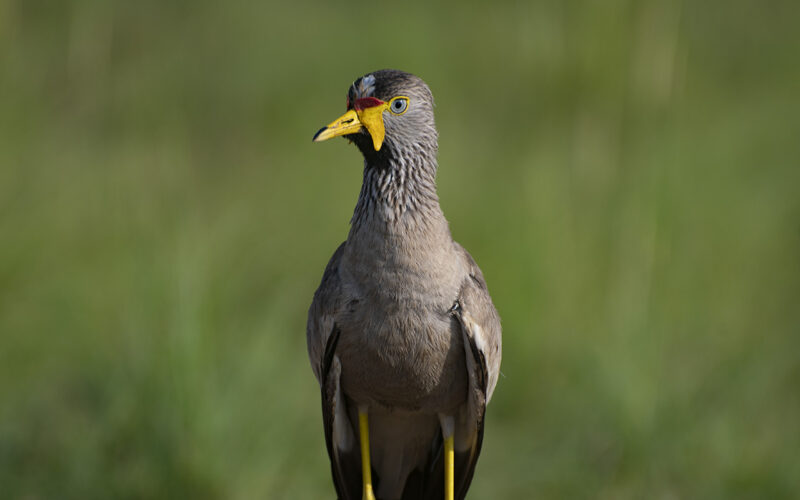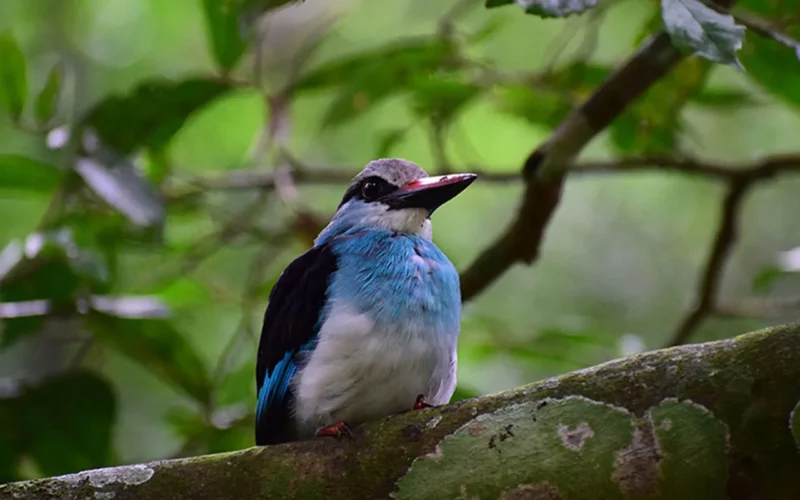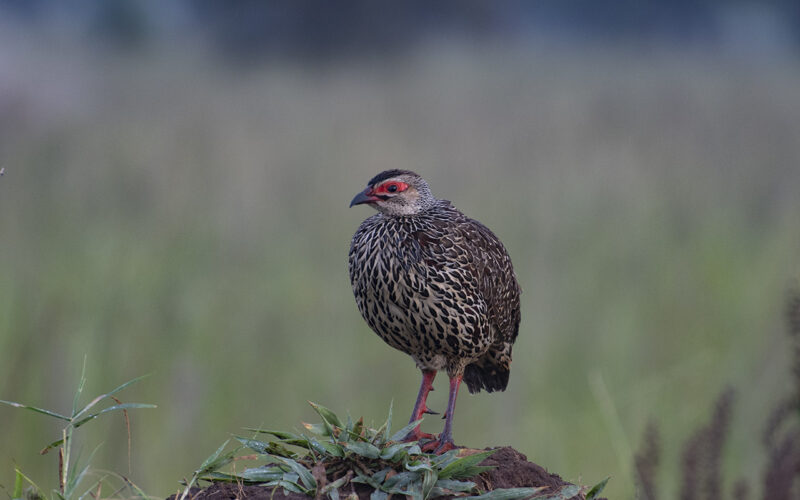Are you planning a birding trip to Uganda? Here are the top 10 Uganda birding hotspots to explore on a Uganda birding trip. Read on to get inspired and let us tailor-make a personalised Uganda birding itinerary that fits your expereince, preferences and interests.
Uganda’ diverse Bird Habitats and Biodiversity
Uganda lies at the confluence of Africa’s most important bird habitats ranking this small nation a rewarding bird watching destination. The country’s bird-rich habitats are highly accessible and developed for tourism with excellent bird guides and a wide range of accommodation.
Uganda’s diversity of bird-rich habitats support a checklist of over 1080 species, with two endemic bird species namely; the Fox Weaver (Ploceus spekeoidis) and the Karamoja Apalis (Apalis karamojae). These birding hotspots include vast wetlands and marshes that surround most open water bodies, montane forests, highland marshes that lie within the Albertine Rift hosting up to 24 Albertine Endemics.
Other habitats include savanna woodlands, lowland forests, thorny bush and dry-scrub habitats hosting several horn of Africa bird species on the edge of their westerly range limit. Elsewhere on a Uganda birding trip, birding extends into the intermediate zones including agricultural lands, urban green parks, seasonal grasslands, riverine stretches where a rich selection of local generalist species occur.
Top 10 Birding Hotspots in Uganda – Where to go Birding in Uganda
-
Bwindi Impenetrable Forest National Park
The UNESCO world heritage site of Bwindi is Uganda’s top birding hotspot with a 360-bird checklist that includes the 24 restricted Albertine Endemics. Set along the edges of the Albertine Rift, Bwindi Impenetrable National Park is the most diverse rainforest on the continent protecting half of the global population of the mountain gorillas and other exciting fauna.
Bird Species Highlights at Bwindi Impenetrable Park
Birding at Bwindi Impenetrable Forest is more rewarding from the park’s sector offices of Ruhija and Buhoma, both prime and Uganda’s best birding hotspots with well established birding trails that explore various altitude ranges across this vast rainforest. Birding from these hotspots highlights include; the localized Albertine Endemics of Grauer’s Broadbill, Black-faced Apalis, Rwenzori Apalis, Stripe-breasted Tit, Strange Weaver, Neumann’s Warbler, Regal Sunbird, Grauer’s Swamp Warbler, Grauer’s Warbler, Yellow-eyed Black Flycatcher, Rwenzori Batis, Purple-breasted Sunbird and Handsome Francolin.
Other high-altitude restricted species easily seen at Bwindi include; Pink-footed Puffback, Grey Cuckoo-shrike, Eliot’s Woodpecker, Black-billed Turaco, Black Bee-eater, Mountain Hill-Babbler, Bar-tailed Trogon, African Broadbill, Western Green Tinkerbird, White-tailed Crested Flycatcher, Sharpe’s Starling, African Crowned Eagle, Ayres Hawk Eagle, Montane Oriole, Lagden’s Bush-Shrike, Doherty Bush-shrike and the Kivu Ground Thrush among others.

-
Queen Elizabeth National Park
Queen Elizabeth National Park is a top birding hotspot whose varied habitats host a checklist up 600 bird species, the largest collection from any protected park on the continent. The park lies in the trough of the Albertine Rift Valley overlooking the towering Rwenzori Mountain ranges.
Bird Highlights
Birding across Queen Elizabeth NP vast habitats highlights include; Papyrus Gonolek, White-winged Warbler, African Fish Eagle, Blue-headed Coucal, Slender-billed Weaver, African Martial Eagle, Bateleur, Brown and Black-Chested Snake-Eagles, Black-bellied Bustard, Black-crowned Tchagra, Red-necked Francolin, Senegal Lapwing, Temminck’s Courser, Grassland Pipit, Flappet, Rufous-naped and Red-capped Lark, Blue-naped Mousebird, Black-headed Gonolek, Greater Honeyguide, Spot-flanked Barbet, Lesser Masked Weaver, Lilac-breasted Roller, Striped Kingfisher, Cardinal Woodpecker, Green Wood-hoopoe, Pin-tailed Whydah, among others.
Birding on a cruise along the Kazinga Channel offers chances to encounter flocks of African Skimmer, African Spoonbill, Great White and Pink-backed Pelican, Lesser Stripped Swallow, Yellow-billed Stork, Pied Avocet, Egyptian Goose, Grey and Rufous-bellied Heron, Great Cormorant, Long-toed Lapwing, African Darter, among other waders. The Kazinga channel and other saline crater lakes in Queen Elizabeth NP host several migrating Palearctic species including Lesser and Greater Flamingos congregations.
-
Kibale National Park
Most popular for its Chimpanzee tracking experiences, Kibale Forest is a top birding hotspot featuring on all Uganda birding tours. This moist semi deciduous forest lies on the escarpment edges of the Albertine Rift valley with a checklist of 470 species of birds notably the Guinea-Congo biome, Afro -tropical highlands and Albertine Rift restricted specialists.
Species Highlights
Top of the bird highlights at Kibale Forest include; the forest floor specialist and elusive Green-breasted Pitta (Pitta reichenowi) only known from here. Other forest specialists include; Masked Apalis, Lowland Akalat, Narina Trogon, Afep Pigeon, Yellow-browed Camaroptera, Speckled Tinkerbird, Toro Olive-Greenbul, Olive Long-tailed Cuckoo, Speckle-breasted Woodpecker, Blue-headed Sunbird, Blue-throated Roller, Black-capped Apalis, Grey Parrot, Great-blue Turaco, Crested Guineafowl, Western Nicator, Shining-blue Kingfisher, Blue-throated Brown Sunbird, Dusky-blue Flycatcher, Dusky Tit, Green Hylia, Western-black Headed Oriole, Chestnut Wattle-eye, Equatorial Akalat, Yellow-mantled Weaver among others.
While birding at Kibale NP, an extended session in the bird-rich Bigodi wetland along the park edges offers chances to encounter African Dusky Flycatcher, White-spotted Flufftail, Yellow-Crested Woodpecker, Red-Headed Bluebill, African Blue Flycatcher, Olive Sunbird, Yellow-spotted Barbet, Red-headed Malimbe, Yellow-throated Leaflove and more.

-
Budongo Forest
The semi-deciduous Budongo forest reserve is undoubtedly Uganda’s best birding trail for mid-forest proper specialists. Stretching over various ridges across Bunyoro escarpment, Budongo forest covers an area of 435sq.km hosting a checklist of 366 bird-species list. This incredible bird list include 94 Guinea-Congo biome species, 10 Sudan and Guinea species with 7 Afro-tropical forest species among other forest proper species.
Species highlights
Budongo’s Royal Mile trail is regarded as the best Uganda’s top birding hotspot for the localized canopy specialists unique to the century old mahogany and iron wood trees that line the mile. Bird highlights here include; Yellow-footed Flycatcher known only from here, Rufous-crowned Eremomela, Dwarf and White-bellied Kingfishers, Chocolate-backed Kingfishers, Red-tailed Ant-thrush, Ituri Batis, Chestnut-capped Flycatcher and White-thighed Hornbill.
Other highlights include; Uganda Woodland Warbler, Yellow Longbill, Rufous-sided Broadbill, Cassin’s Spinetail, White-spotted Flufftail, Forest (Fraser’s) Flycatcher, African Shrike Flycatcher, Green Sunbird, Crested Guineafowl, Yellow-billed Barbet. On the forest edge White-breasted Nigrita, White-collared Oliveback, Cabani’s Bunting, Heuglin’s Francolin, Fan-tailed Grassbird, Dark-capped Yellow Warbler, African and Jameson’s Firefinch occur.
-
Semuliki National Park – A birder’s Haven
Set on the northern foothills of Rwenzori mountain ranges, the 220 sq.km Semuliki National Park is a birding hotspot with spectacular diversity of bird specialists unique to this semi-deciduous lowland forest. Semliki Forest sometimes referred to as Bwamba Forest is an easterly extension of the expansive great Ituli lowland forest of Congo bringing onto Uganda checklist an impressive collection. The forest hosts a 478 species checklist comprising of up to 144 species of Guinea-Congo Forest biome specialists that come on their eastern range limit.
Species Highlights
Bird highlights at Semuliki Forest include up to 7 species of hornbills including; Eastern Little, Congo Pied, Dwarf, Eastern Long-tailed, Eastern Piping, White-thighed and the gigantic Black-casqued Hornbills. Other stop specialists to look out for include Hartlaub’s Duck, Black Coucal, Grant’s Bluebill, Spot-breasted Ibis, Nkulengo Rail, Rufous-sided Broadbill, Long-tailed Hawk, Blue-breasted Kingfisher, Simple Greenbul, White-naped and Olive Pigeons.
Other notable birds include; African Piculate, Zenker’s and Spotted Honeyguide, Sassi Olive Greenbul, Lowland Sooty Boubou, Fiery-breasted Bush-shrike, Maxwell’s Black-weaver along with Dusky-blue Flycatcher, Black Coucal, Yellow-throated Nicator, Xavier’s Greenbul, Yellow Longbill, Blue-billed and Crested Malimbe, Red-billed Helmet-shrike, Pale-fronted Nigrita, Red-eyed Puffback, Leaflove, Western-black Headed Oriole, Bronze-naped Pigeon, Yellow-throated Cuckoo are just the reason this forest keep attracting twitchers from across the globe!
-
Lake Mburo National Park
Uganda’s smallest savanna national park, Lake Mburo NP lies in the rain shadow west of Lake Victoria extending just over 260km2 of undulating territory with an altitude range from 1220m-1828m. With a fairly low annual rainfall of 600mm-1000mm, most of the park’s vegetation is dominated by open savanna and wooded grasslands, rocky hillsides to seasonal and permanent wetlands harboring a checklist of 315 bird species.
Species Highlights
Top of bird highlights in Lake Mburo National Park is a selection of Zambezian biome species on their northerly-range limit here including; Southern Black Flycatcher, Southern Carmine Bee-eater, Southern Ground Hornbill, Red-faced and Black-collared Barbet, Tabora Cisticola and more. Birding on a cruise along Lake Mbulo provides high chances to encounter the shy African Finfoot. The papyrus hide Papyrus Gonolek, Caruthers’s Cisticola and White-winged Warbler whereas the Lesser and Greater Swamp Warblers are often encountered with an ease!
Other grassland specialists include; Yellow-throated Longclaw, Flappet Lark, Temminck’s Courser, Coqui and Crested Francolin, Grey-crowned Crane, Black-breasted Bustard, the beautiful African Wattled and Senegal Lapwing. The intra African migrating Brown-chested Lapwing often pass through these woodlands from late October to May.
Woodland specialists include Senegal and White-browed Coucal, Yellow-breasted Apalis, Arrow-marked Babbler, Red-faced Crombec, African Grey Hornbill, Black-headed Gonolek, Greater Honeyguide, Trilling and Whistling Cisticola, Blue-spotted and Emerald-spotted Wood-Dove, Red-headed Lovebird, White-winged Black Tit and Spot-flanked Barbet and more. Yellow-fronted Tinkerbird, Black Cuckoo-shrike, Stripped Kingfisher, Blue-Naped Mousebird, Didrik Cuckoo, African Penduline Tit, Sulphur-breasted Bush-shrike, Red-headed Weaver, Green-winged Pytilia, Bare-faced Go-away Bird, Chinspot Batis and the rare Black-headed Batis, Tambourine Dove, Ruppel’s Starling, Red-chested Sunbird among others.
Raptors include Brown and Black-chested Snake Eagle, Butler, African White-backed Vulture, Tawny, Steppe Eagle occur. The park’s rocky hills sides are a home to Cinnamon-breasted Bunting, Familiar and Sooty Chat.
-
Murchison Falls National Park
The expansive Murchison Falls NP is Uganda’s and largest park covering an area of 3840km2 of diverse habitats with a checklist of 460 species of birds. Birdwatching here explores several regional biomes that converge here including Sudan-Guinea grasslands, the dry-scrub and grasslands similar to Somali-Masai biome, and Guinea-Congo Forests characters in Budongo Forest.
Split by the Victoria Nile into the northern banks and southern banks areas, the park embraces a variety of habitats ranging from Borassus palm dotted savanna plains and wooded grasslands, papyrus wetlands and marshes, to woodland, acacia dominated gullies to dense lowland forest. The relatively flat landscape ranges from altitudes of 650m-1292m with average temperatures hotter comparing to the rest of the country thus influencing the biodiversity.
Species Highlights
The expansive Murchison Falls NP’s diverse habitats is better explored individually for incredible local species unique to these these habitats.
- Birding on Northern Nile banks in Murchison Falls NP
Birding the savanna plains, open bush and woodlands species highlights include; Palm-nut Vulture, Palm Swifts, Silverbird, Black-billed Barbet, Yellow-bellied Eramomera, Red-pate, Croaking, Foxy and Rattling Cisticolas, Black-billed Wood Dove, Little, Swallow-tailed, and the seasonal Northern Carmine Bee-eaters. The wooded grasslands host the Vitelline Masked, Speckle-fronted and Compact Weavers, Lesser Blue Eared Starlings, Fork-tailed Drongo, Piapiac, White-crested Helmet-shrike, White-browed Sparrow Weavers, Yellow-billed Shrike, Black-breasted Barbet, Grey-headed Kingfisher, Black Scimitar bill, Rufous-crowned Roller often occur in Acacia woodland.
Grasslands hosts; Red-capped Lark, Black-headed Lapwing, Crowned Lapwing, African Hoopoe, and the beautiful African-Wattled lapwing, Spotted Dikkop is regular, Black-bellied and Denham’s Bustard, Abyssinian Ground-Hornbills pairs roam the grasslands.
Raptors are well represented in; Martial Eagle, Bateleur, Grey and Dickson’s Kestrel, Beaudouin’s, Brown and Black-chested Snake-Eagle, Fox Kestrel, Lanner Falcon, Dark-Chanting Goshawk, Tawny and Walberg’s Eagles, and other passage visitors. White-headed, African White-backed and Lappet-faced Vultures. Verreaux’s Eagle Owl, is occasionally seen in the Acacia woodland. Other raptors encountered on their North-South migration include Grasshopper Buzzard, Peregrine and Amur Falcons among others. Secretary Bird wanders through the grasslands.
The near/nocturnal residents include Long-tailed Nightjar, Pennant-winged Nightjar and Standard-winged Nightjar whose impressive wing projections in Sept-April are on full display during this breeding season.
- Birding the Nile and Lake Albert Delta in Murchison Falls NP
The Victoria Nile sand cliffs near the base of Murchison Falls are the breeding colonies of the dazzling Red-throated Bee-eaters, while a boat cruise south- wards to the Delta provides excellent views of African Fish Eagle, African Pied, Malachite and Giant Kingfisher, Palm-nut Vulture, in season Pallid Harrier, African Marsh Harrier, Spotted Eagle Owl while the shallow water side vegetation is a good hunting grounds for waders like Goliath, Grey Herons, Yellow-billed and Saddle-billed Stork.
The rich shallow marshes around The Delta on L. Albert is a great place to look for African Skimmer, African Darter, Grey-headed Gull, White-winged black Tern, Black Heron, Yellow-billed Ducks, White-faced and Fulvous Whistling Ducks, and migrant visitors in their thousands.
The thick papyrus is home to Purple Swamp Hen, Black Crake, Vieillot’s and Golden-backed Weaver, Blue-headed Coucal, Papyrus Gonolek, Winding Cisticola and others.
Note: The Delta’s shallow floating vegetation is one of the few reliable places to encounter the Shoebill.
- Birding Butiaba escarpment and Bugungu wildlife reserve.
The reserve lies within greater Murchison Falls Conservation Area, extending along the floor of rift valley near L. Albert to the edge the escarpment protecting Open Bush, Dry-scrub, Savanna woodland, Acacia wooded riverine, and grassland communities of vegetation. Species unique to this habitat include, Black Cuckoo-shrike, Striped Kingfisher, Black-billed, Spot-flanked Barbet, African Grey Hornbill, Woodland Kingfisher, Southern Ground Hornbill, Long-crested Eagle, Lesser-blue Eared Starling, Chestnut-crowned Sparrow Weaver, Namaqua Dove, Cut-throat Finch, Cinnamon-breasted Bunting, Foxy Cisticola among others.
-
Mgahinga Gorilla National Park
Uganda’s smallest and most scenic, Mgahinga Gorilla National Park protects a 33km2 of bamboo and montane forest zones on the Uganda’s side of Virunga Volcanic massifs that straddles three international borders of Uganda, Rwanda and the D.R.C. Mgahinga NP is a popular destination for close-up mountain gorilla and golden monkey trekking experiences across these montane ranges.
Mgahinga National Park offers a rewarding birding experience targeting the local specialists across its bamboo zones, montane forests and secondary forests zones. The park lies within the Albertine rift biome zone sheltering 119 species checklist that includes 14 Albertine rift endemics, 39 Afro-tropical highlands biome species and 4 globally threatened species.
Species Highlights
Birding across Mgahinga national park’s excellent trails highlights include the colorful Rwenzori Turaco, Rwenzori Double-collared Sunbird, Regal Sunbird, Lagden’s Bushrike and Red-throated Alethe while Black-billed Turaco, Mountain Masked and Collared Apalis. The Natal Robin Chat, Kivu Ground Thrush, White-starred Robin, Olive Thrush, Mountain Boubou, are active in the secondary forest.
Cape and White-browed Robin Chats, Western Green Barbet, Mountain Yellow Warbler are common along the forest edge while Archers Robin frequents the steep ascends around 3000m.
-
Birding the Kidepo Valley National Park
The 1442km2 Kidepo National Park is a true African wilderness and Uganda’s top birding hotspot tucked in the remote north-east region of Uganda. Lying some 520 km away from Kampala, it has been off the radar of most birders due to its remoteness. With rugged savanna plains, lush mountain ranges and hot-springs, Kidepo Valley NP spans altitudes of 914m-2750m. With just an annual rainfall of 800mm, the semi-arid vegetation ranges from savanna grassland and woodlands, dry shrub thicket and bush-land are interspersed with rocky outcrops.
The entire region including the Matheniko/Bokora Reserve south of Kidepo NP lie entirely in the Somali-Masai biome. The park protects a stunning checklist of 480 species including 23 species out 32 species unique to this dry-country and semi-arid habitat and rarely occurring anywhere else in Uganda!
Species Highlights
Kidepo’s bird checklist include rare Ethiopian and greater horn of Africa species that are on their southern and easterly range limits. Among these is a incredible collection of raptors including, Eastern-Chanting and Dark-Chanting Goshawk, Pygmy Falcon, Tawny Eagle, Secretary Bird, Lesser, Fox and Greater Kestrels. Rare scavengers include the vulnerable listed Lappet-faced Vulture, Egyptian Vulture and occasional Lammergeier (Gypaetus barbatus).
Highlights of dry-bush species include, Karamoja Apalis, Superb, Bristle-crowned and Magpie Starlings, Pale Prinia, Pygmy Batis, Pygmy Sunbird, Yellow-billed Shrike, Yellow-necked Spurfowl, Rufous Chatterer, Parrot-billed Sparrow, Grey Wren Warbler, Eastern Violet-backed Sunbird, White-headed Buffalo Weaver, Purple Grenadier, Taita Shrike, White-bellied Go-away bird, Abyssinian Roller, Three-Streaked Tchagra, Northern White-crowned Shrike, Grey-capped Social Weaver, Fan-tailed Raven, D’Arnaud’s Barbet, Red-and-yellow Barbet, Red-winged Lark, Denham’s, White-bellied, Buff-Bellied and Hartlaub’s Bustards, Spotted-thick Knee and Three-banded Plover.
-
Mabamba Wetlands
Mabamba wetland is listed as Important Bird Area extending some 100km2 from the shallow marshy bay on the northern shores of Lake Victoria. The extensive marsh with its open water channels has until recent become a top birding spot for birders due its growing numbers of the rare wetland resident – the Shoebill. Conservation Agencies in partnership with Mabamba Wetland Community Association work together to protect this Ramsar site and its biodiversity.
Species Highlights
Paddling through the open channels on a local canoe gives access to the wetland interior where a checklist of 250 bird species of which some are globally-threatened. To visiting birders and enthusiasts the highlight of these marshes is local dozen pairs of the Shoebill protected in this expansive wetlands along several Lake Victoria biome species.
Other species of interest include seasonal congregations of Gull billed Terns, White-winged Black Tern, Whiskered Tern, Ruff and several Sandpipers including resident Grey-headed Gulls, Little Stint, Yellow Wagtail, Eurasian Marsh Harrier and Osprey occur seasonally while African Marsh Harrier, African Fish Eagle, Palm-nut Vulture are resident raptors.
The marsh is the best place to look out for Blue-Swallow a migrant from south equator that occur from May to September.
Other papyrus species include; Blue-breasted Bee-eater, Black-crowned Night Heron, Striated Heron, Pygmy and Spur-winged Geese, White-faced Whistling Ducks, Black Stilt, Purple, Reed Cormorant, Papyrus Gonolek, and Purple and Grey Heron, Northern Brown-throated Weaver, Malachite Kingfisher, Black crake, Lesser and African Jacana, Pied Kingfisher, Carruthers’s and Winding Cisticola and many others.
The marsh edges and cultivation attract; Long-crested Eagle, Scarlet-chested and Marico Sunbirds, Western-Banded Snake Eagle, Lizard Buzzard, Red-eyed Dove, Speckled-mouse bird, Black-headed weaver, African Pied Wagtail, Yellow-fronted Canary, Spectacled Weaver, Hamerkop, Open- billed Stork and many others.
More Birding Hotspots recognised as Important Birding Areas and Ramsar Sites
The following birding hotspots also on Uganda birding tours and are usually explored as Day-tours due their small size and due to lack of standard amenities like accommodations. and lie off Uganda’ major birding circuit. nonetheless, they support a great diversity of birdlife.
- Mabira Forest
- Lutembe Bay
- Mpanga Forest
- Sango Bay
- Lake Bunyonyi
- Nyamuriro Swamp
- Echuya Forest
- Rwenzori Mountain Ranges
- Butiaba Escarpment
- Matheniko Wildlife Reserve
- Pian Upe Game Reserve
- Mt. Moroto
- Ziwa rhino Sanctuary

